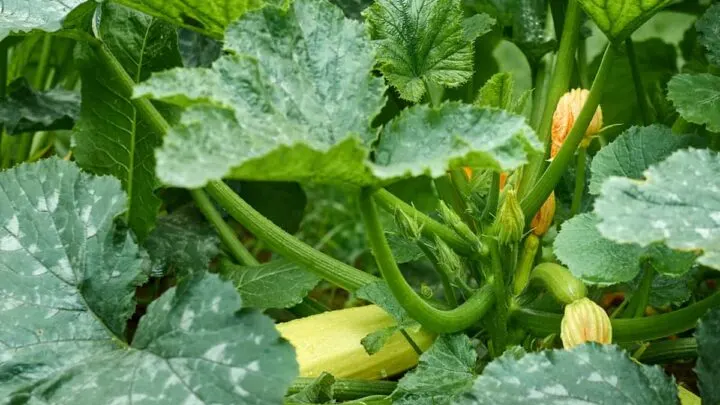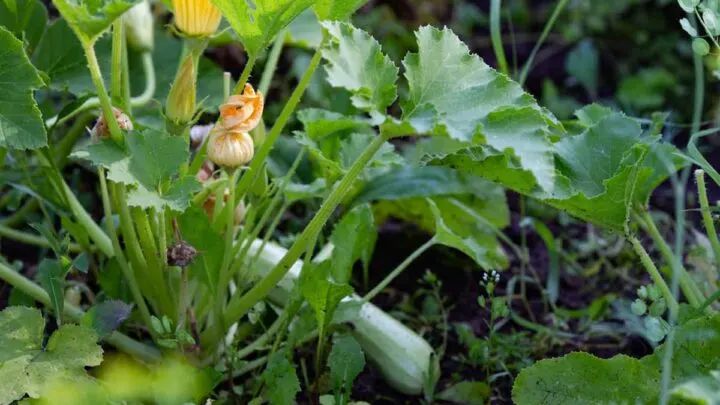Zucchini is one of the more popular garden vegetables because it can be used as a versatile cooking ingredient in everything from pasta to stir fry and even zucchini bread desserts.
Growing your own zucchini is an excellent way to help make sure they’re fresh, the right size, and packed full of nutrients and flavor.
Here’s what you need to know to grow zucchini in a raised bed, whether you’re already a garden expert and need some specific advice for zucchini or have never grown a vegetable before in your life.

How To Prep A Raised Bed For Zucchini
Getting a raised bed ready before planting is one of the secrets to a successful garden. One of the significant advantages of raised beds is that you can prep almost perfect growing conditions for the vegetables you want to grow.
Here’s what you need to know to grow zucchini successfully.
How Deep Does Your Raised Bed Need To Be?
Zucchini is one of the vegetables that need a relatively deep raised bed to have enough room to grow. If your zucchini raised bed isn’t raised above the ground and still connects to the natural ground, you don’t need as much height.
If you want to raise the bed completely off the ground, you may want to do as deep as 20-24 inches to ensure there is room for the zucchini roots and for proper drainage.
Raised Bed Placement: Full or Partial Sun?
Like many squash and other vegetables, zucchini needs a lot of sun to photosynthesize enough nutrients to grow fruit. While too much sun can cause wilt or sun damage, for the most part, more sun means more nutrient availability and better growth.
For zucchini, raised beds should be placed somewhere with at least 6-8 hours of full direct sunlight. A couple of additional hours in partial sun can help boost growth times and lead to larger yields.
What Soil Temperature For Planting Zucchini
Zucchini tends to be a fast-growing vegetable. Both the plant and the fruit develop quickly, but one of the reasons they can grow that fast is because they don’t grow much protection from the cold.
You should wait to plant zucchini until the soil is relatively warm. Ideally, you should wait until the temperature in the soil reaches at least 60 degrees.

How To Prepare Raised Bed Soil For Planting Zucchini
Soil for zucchini needs good drainage and needs to be relatively loamy and full of organic content. That means that zucchini will thrive in relatively sandy soil as long as lots of compost or other organic materials are included in the mix.
Zucchini doesn’t want a lot of clay and only moderate silt in their soil. And it’s more important to make sure there is plenty of organics in their soil than to make sure it meets any other important qualities for their growth.
Fertilizing and adding compost to the raised bed up to a week before you plant will help ensure there are enough nutrients and enough organic content to support zucchini growth.
How To Plant Zucchini In Raised Beds
Planting zucchini in raised beds isn’t that different from planting in the ground, but it does mean that you need to treat the plants a little differently. Here’s what you need to know to help your zucchini thrive and get a good crop.
Sew Seeds Or Buy Seedlings?
Zucchini is a fast-growing plant, and they’re also relatively delicate, which means that they aren’t going to handle transplants well. That means that there isn’t a lot of advantage to starting seeds inside.
Instead, wait for the weather to warm up enough and plant the seeds themselves in the grow bed you want to grow your zucchini. Your seeds will almost certainly sprout more than you can grow together, but you can thin them down to the most successful/strongest sprouts.
If you aren’t sure if your soil is ready to plant, wait a week for the temperature to warm back up further.

When To Plant Zucchini
Zucchini should never be planted before the last frost of the year. You may want to leave off planting zucchini until the weather starts to transition from spring into summer weather so that the soil heats up a little more and there’s less risk of cold damage.
You also need to make sure the temperature isn’t dropping below 40 degrees at night before planting zucchini.
That can mean different times, even in the same hardiness zone. So rather than sticking to a specific date or even week for planting your zucchini, you’ll have better results if you’re just in tune with the weather and when the soil is ready enough.
How To Attract Pollinators
While zucchini can be hand pollinated, you typically won’t get as many fruits per plant as you would from natural pollination. You’ll also typically get as frequent a harvest as with natural pollination.
The problem is that unless you’re growing a lot of zucchini at once, zucchini alone probably won’t produce enough flowers to attract natural pollinators.
Instead, you should companion plant other blooming plants, flowers, fruits, and vegetables, nearby that will help attract pollinators naturally.
Some good plants to use for attracting pollinators include:
- Calendula
- Marigold
- Zinnias
- Cosmos
- Lavender
- Mint
- Bee Balm
- Lilac
You don’t need all of these plants, but at least 1 or 2 plants with many blooms will make your garden much more attractive for pollinators.
Trellising Zucchini
You should have a trellis ready for your zucchini as soon as they reach about 6 inches long and should start trellising them or trellis training them as soon as the vine starts to bend and trail along the ground.
At first, if you don’t want to plant the trellis feet right next to the vine, you may need to use twigs or twine to help guide the plant to the trellis. As your zucchini grow, watch to make sure they’re vining around the trellis as much as possible, and feel free to guide the young stem (before it starts to stiffen) through the trellis in your desired pattern.
Remember, the goal is to offer support and ensure the whole vine gets enough sunlight, not completely covering the trellis.
Fertilizing Raised Bed Zucchini
Zucchini is a relatively hungry vegetable and need a good amount of fertilizer to keep producing fruit. You should fertilize a little more often and with a higher-nutrient fertilizer than some other vegetables.
Don’t add more fertilizer than recommended; that will burn your plant’s roots and stop your zucchini from growing. Instead, look for balanced 10/10/10 fertilizers or fertilizers that offer slightly more nitrogen or potassium, like a 12/10/10 (the first number is nitrogen) or an 11/10/12 (the last number is potassium) for good results.
Fertilize roughly every two weeks or more often if your fertilizer recommends more often. Never exceed how often the fertilizer recommends to be used because doing so risks chemically burning the roots and low stem.

Preventing And Controlling Common Zucchini Pests & Diseases
Here are some of the most common zucchini pests and diseases and what you can do to help control them or keep them out of your garden.
Cucumber Beetles and Squash Borers
Cucumber beetles and squash borers both can attack the leaves, stems, and zucchini squash themselves and can cause serious problems to the whole plant. Both kinds of beetle will eventually spread to other nearby plants.
Insecticidal soap and other insecticides can be used to control the beetles. Garden spiders and praying mantises can also be a good control measure.
Powdery Mildew
Powdery mildew is a common fungal disease that affects a wide range of garden plants, including both vegetable plants and flowers. This disease can be spotted when you see a thin white powder on the leaves, blossoms, and vegetables.
Most anti-fungal plant treatments will tackle powdery mildew, but it can be a persistent and recurring problem. Continuing to treat the problem can help, but powdery mildew is also a sign that the plants are stressed.
Testing soil and making sure you don’t overwater the plants and add fertilizer or other soil supplements to help make sure they aren’t lacking nutrients.
Blossom Rot
Blossom rot is largely a result of calcium deficiency in the soil. Adding calcium supplements can help resolve blossom rot in zucchini. Still, it’s better to ameliorate the soil with extra calcium before blossom rot occurs rather than trying to fix the problem after the rot has started.
Bacterial Wilt
Bacterial wilt is a disease in the soil that can cause both root and leaf problems in your zucchini plants. Bacterial wilt can sometimes be treated with broad-spectrum pest and disease control solutions, but it’s hard to control or catch early enough to successfully treat the disease.
Instead, you should remove and dispose of affected plants. Don’t compost the plants because that may transfer the disease into the compost, where it can spread further.

Hi there, my name is Allie and welcome to my blog; GareningWithAllie!
Much of what you see written here is just our personal experiences with gardening. Along with the content I write here, there is also a unique collection of gardening topics covered by some of our close friends. I hope you find everything you read here to be helpful, informative, and something that can make your gardening journey the most lovely experience ever! With that said, Happy Gardening!
